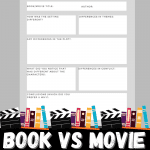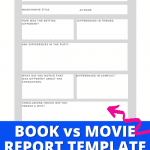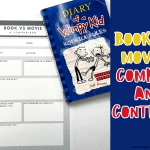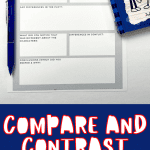Free Book and Movie Comparison Worksheet for Kids
Using a book and movie comparison worksheet has completely changed how we approach reading and watching stories in our home.
What started as a casual activity quickly became one of our favorite ways to dig deeper into books—and yes, it even got my son excited about writing!
We’ve had some great conversations after noticing how characters or scenes were changed in the film version, and the worksheet helped organize those thoughts without it feeling like another assignment.
It’s a simple tool, but it turns screen time into something way more meaningful.
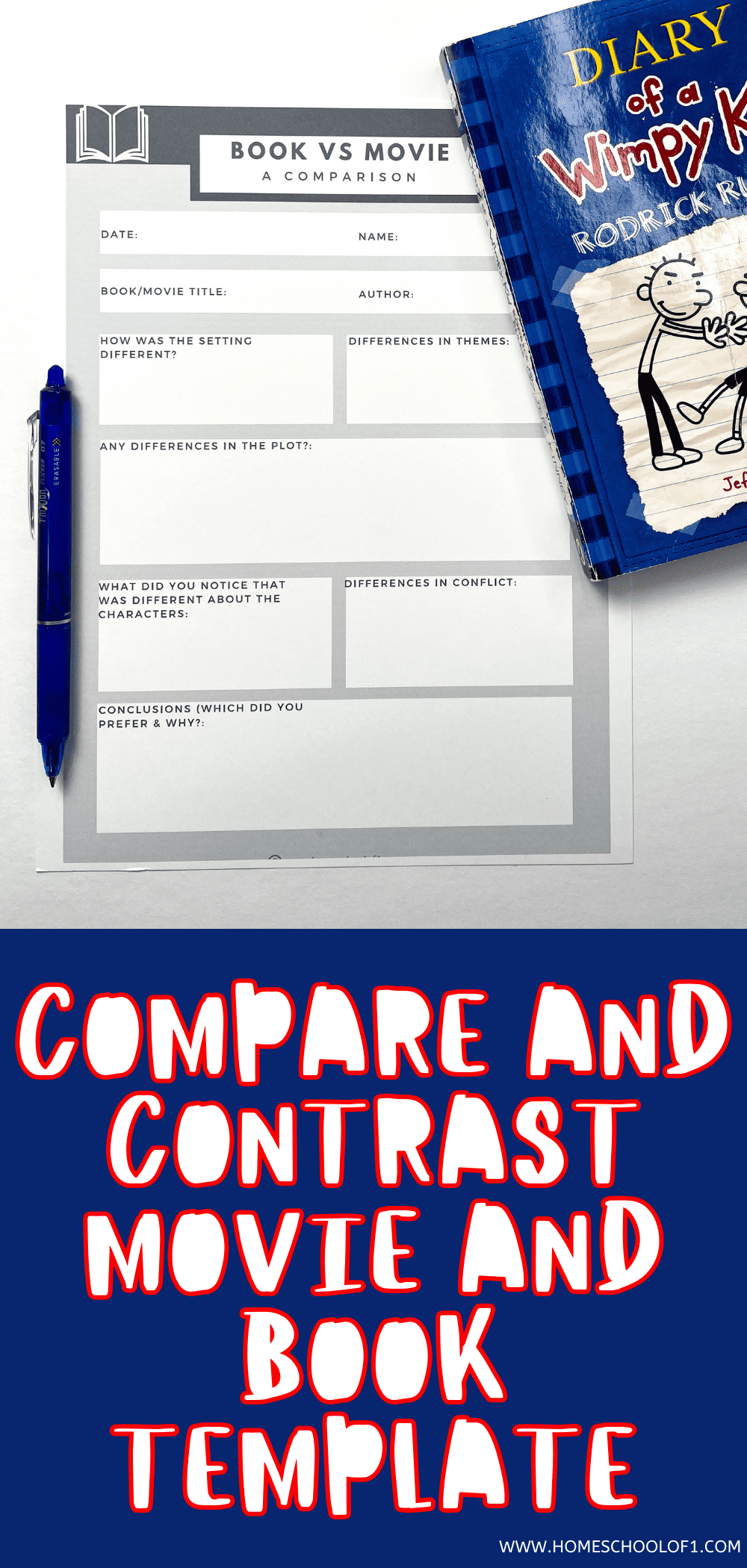
**This post may contain affiliate links. As an Amazon Associate and a participant in other affiliate programs, I earn a commission on qualifying purchases.**
Movie and Book Comparison Worksheet
This free printable worksheet has become one of our favorite tools for analyzing book and movie adaptations together.
It helps kids clearly map out similarities and differences, making it easier to organize their thoughts and write stronger essays.
Instead of just passively watching or reading, students take an active role in comparing how the story is told across both formats. It’s a great way to strengthen critical thinking and writing skills without it feeling like a chore.
Here’s what the worksheet covers:
- Plot Differences – Track how key events unfold differently between the book and the film.
- Theme Shifts – Examine how the central message might change or stay consistent.
- Setting Comparison – Note any changes in time period or location across the two versions.
- Character Variations – Look at how characters are portrayed and developed in each medium.
- Conflict Analysis – Explore how challenges are presented and resolved.
- Final Thoughts – Students choose which version they preferred and explain why.
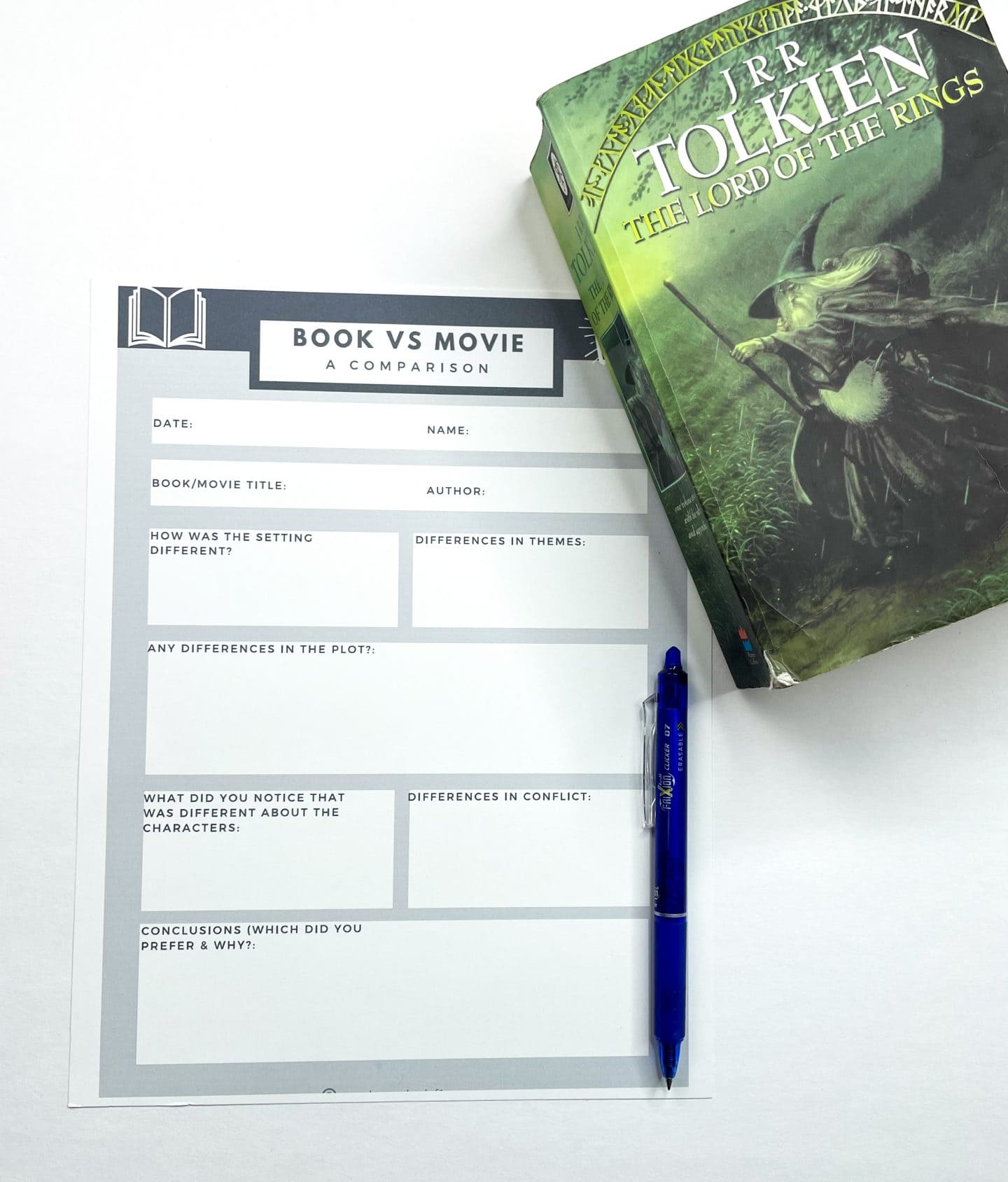
Educational Benefits of Using a Movie vs Book Worksheet
This activity works well for all types of learners. Visual learners absorb details by reading the book and watching the film, auditory learners tune into dialogue and narration, and kinesthetic learners engage through writing and reflection.
Comparing a book and its movie adaptation encourages deeper thinking. Kids move beyond basic comprehension as they analyze story elements, spot differences, and consider the reasons behind those changes.
Reading the book first also helps improve focus and memory. When students know they’ll be comparing versions, they read more attentively and retain more specific details.
In today’s media-heavy world, learning how stories are adapted for film builds media literacy. Kids become more thoughtful viewers as they begin to question why scenes were cut or characters changed.
Finally, the worksheet encourages students to form opinions and support them with examples—an essential skill for persuasive writing and communication.
Want to take it further? Try our free middle school book report template to keep the momentum going.
How to Write the Comparison
Once your kids have filled out the worksheet, take it a step further by turning their notes into a short essay. Here’s how we make the writing process easier and more structured at home:
- Start with a Venn diagram – This helps visually sort out key similarities and differences before writing begins. It’s our go-to prewriting step.
- Keep the thesis simple – One clear sentence that says what they’ll be comparing makes a big difference.
- Use clear transitions – Words like “in contrast” or “similarly” help kids connect their ideas smoothly.
- Add specific examples – A scene, a quote, or a character change adds weight to their points.
- Always revise – My son never loves this part, but reading through and fixing rough spots really improves the final result.
We’ve found this turns a basic worksheet into a solid writing exercise—without the groans that usually come with essays.

Favorite Book and Movie Adaptations for Kids
Some book-to-film adaptations really stand out—not just for their entertainment value, but for the rich conversations they spark. These are the ones we’ve enjoyed the most at home, and they’ve made comparing stories a lot more fun (and meaningful).
Here are five of our favorites:
Harry Potter Series – This one tops the list in our house. The magical settings and deep friendships make for great discussion, especially when scenes or characters are changed in the movies.
The Lord of the Rings – A fantasy classic with big themes like courage and loyalty. It’s great for analyzing how character arcs and story pacing shift in film form.
Oliver Twist – A powerful story to explore historical context and social issues. The movie gives a very different tone and perspective compared to the book.
Wonder – This one opens up conversations about empathy and kindness. The emotional depth of the book comes through differently on screen, making it perfect for a thoughtful comparison.
David Walliams’ Collection – These are ideal for younger kids. The humor and quirky characters are portrayed in such unique ways across the page and screen—it’s fun to spot the differences.
Need to print later? Add this to your Pinterest board or share it on Facebook. You’ll have it handy whenever you’re ready to use it!
Get the Compare and Contrast Movie and Book Template Here!
Ready to grab your free printable? Just pop your name and email into the form below, and it’s all yours!
What are your kid’s favorite books that have been turned into films? Let me know in the comments below.
It’s a printable tool that helps students organize their thoughts when analyzing the differences and similarities between a book and its film adaptation. It typically includes sections for plot, character, setting, theme, and personal opinion.
This activity encourages deeper thinking and improves reading comprehension, writing, and media literacy. It helps kids recognize how stories are told differently across formats and builds strong analytical and communication skills.
The worksheet is best suited for upper elementary to middle school students (grades 4–8), but it can be adapted for younger or older learners depending on their reading and writing ability.
Last Updated on 7 April 2025 by Clare Brown

